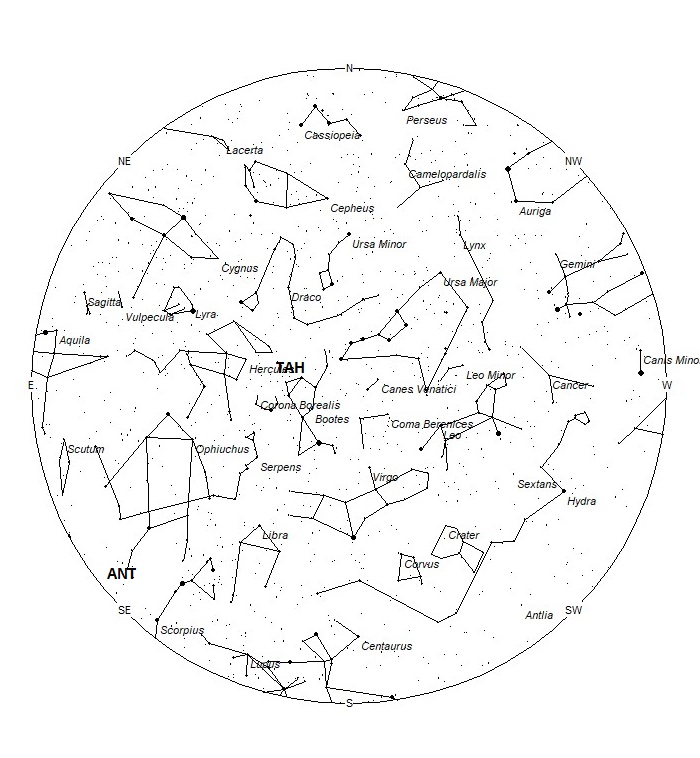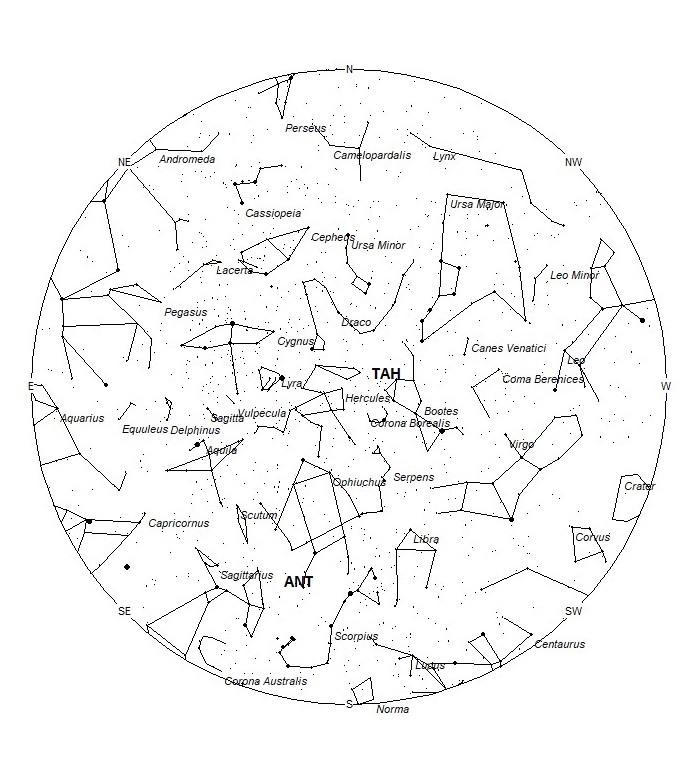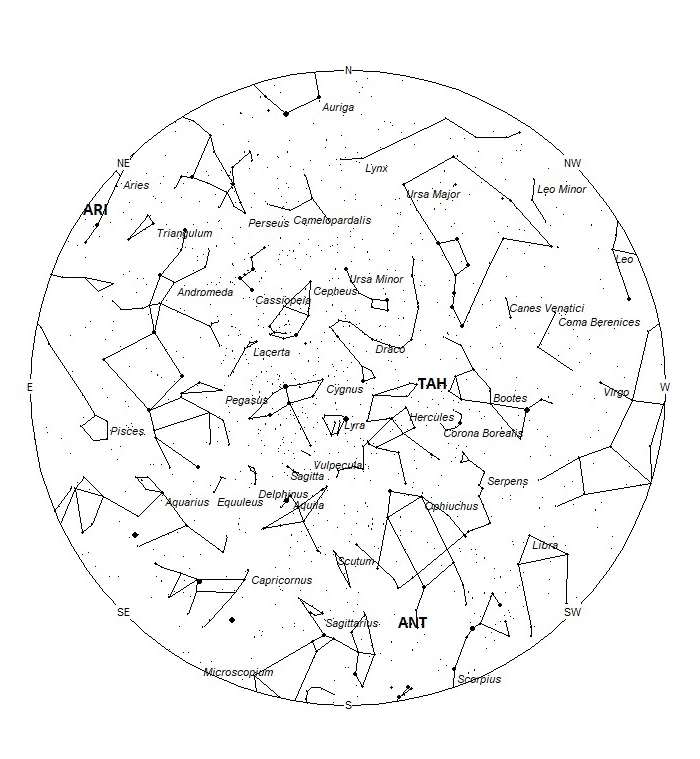 Aaron Morris captured this nice fireball at 08:39 UT on April 21, 2021, from Griffin, Georgia, USA. Despite the fact that this fireball occurred near the Lyrid peak, it is not a Lyrid meteor. ©Aaron Morris
Aaron Morris captured this nice fireball at 08:39 UT on April 21, 2021, from Griffin, Georgia, USA. Despite the fact that this fireball occurred near the Lyrid peak, it is not a Lyrid meteor. ©Aaron MorrisAs seen from the Northern Hemisphere, June is another slow month for meteor activity. There are no major showers active in June and only the Anthelion source can be counted on for continuous activity. Sporadic rates continue to remain low as seen from the mid-northern hemisphere (45 N) with only half the rates seen from the mid-Southern Hemisphere. For the upper half of the Northern Hemisphere the nights are short to non-existent this time of year. As seen from the southern tropics (25 S) sporadic rates continue to be strong this month with morning hourly rates exceeding 10.
During this period, the moon reaches its last quarter phase on Wednesday June 2nd. On this date the moon is located 90 degrees west of the sun and rises near 02:00 local daylight saving time (LDST). This weekend the waning gibbous moon will rise during the early evening hours and will create difficult conditions for view meteor activity the remainder of the night. The estimated total hourly meteor rates for evening observers this week is near 2 as seen from mid-northern latitudes (45N) and 3 as seen from tropical southern locations (25S). For morning observers, the estimated total hourly rates should be near 5 as seen from mid-northern latitudes (45N) and 9 as seen from tropical southern locations (25S). The actual rates will also depend on factors such as personal light and motion perception, local weather conditions, alertness, and experience in watching meteor activity. Rates are reduced during this period due to moonlight. Note that the hourly rates listed below are estimates as viewed from dark sky sites away from urban light sources. Observers viewing from urban areas will see less activity as only the brighter meteors will be visible from such locations.
The radiant (the area of the sky where meteors appear to shoot from) positions and rates listed below are exact for Saturday night/Sunday morning May 29/30. These positions do not change greatly day to day so the listed coordinates may be used during this entire period. Most star atlases (available at science stores and planetariums) will provide maps with grid lines of the celestial coordinates so that you may find out exactly where these positions are located in the sky. A planisphere or computer planetarium program is also useful in showing the sky at any time of night on any date of the year. Activity from each radiant is best seen when it is positioned highest in the sky, either due north or south along the meridian, depending on your latitude. It must be remembered that meteor activity is rarely seen at the radiant position. Rather they shoot outwards from the radiant, so it is best to center your field of view so that the radiant lies at the edge and not the center. Viewing there will allow you to easily trace the path of each meteor back to the radiant (if it is a shower member) or in another direction if it is sporadic. Meteor activity is not seen from radiants that are located far below the horizon. The positions below are listed in a west to east manner in order of right ascension (celestial longitude). The positions listed first are located further west therefore are accessible earlier in the night while those listed further down the list rise later in the night.
These sources of meteoric activity are expected to be active this week.
Details of each source will continue next week when viewing conditions will be much improved.
| SHOWER | DATE OF MAXIMUM ACTIVITY | CELESTIAL POSITION | ENTRY VELOCITY | CULMINATION | HOURLY RATE | CLASS |
| RA (RA in Deg.) DEC | Km/Sec | Local Daylight Saving Time | North-South | |||
| tau Herculids (TAH) | Jun 02 | 15:06 (227) +41 | 15 | 00:00 | <1 – <1 | III |
| Anthelion (ANT) | – | 17:28 (262) -23 | 30 | 02:00 | 1 – 2 | II |
| Daytime Arietids (ARI) | Jun 04 | 02:31 (038) +23 | 40 | 11:00 | <1 – <1 | IV |
 American Meteor Society
American Meteor Society



9:56pm cdt Bixby Oklahoma 74008 28 may 2021 witnessed a fire ball going from my view- north to east for around 45 seconds with a fiery tail that was a hundreds of thousands of miles long.
Witnessed a fireball with a tail trailing it the entire time in the southern direction headed directly down towards the horizon. This was at 10:07pm on May 31st I Tuscaloosa, AL.
North Central Arkansas. May 30,2021. Large fireball observed moving from NNW up to SSE down. About 22:00 cst. It had a long tail and was red to orange. Notably about 5-10 mins prior to the ISS passing in a slightly lower attitude.
Saw one yesterday around the time frame of 11:30 P.M. – 12 A.M; meteorite was going from East to West at a rapid speed. Lit up the whole sky a blue / white like color. (Actually scared me when it happened) definitely was a sight to see!!
Witnessed something Around 1:20 AM near Scorpius constellation on June 3rd. I don’t know much about astronomy, how can I understand if I have seen a fireball?
Flora and All,
A meteor is a streak of light that lasts only a few seconds or less. A fireball is a meteor that is brighter than all objects in the sky except the sun and moon. If your object lasted longer than an few seconds, then most likely the object you saw was a satellite. I hope this helps!
Three slow moving bright meteors in 10 minutes late evening june 3rd. All. Moving S to N, apparently the same radiant somewhere near anthelion… I came here to see what exceptional early june meteor shower I hadnt heard of and I still dont know 🙂
Gordon and All,
June is normally a slow month for meteor activity. Seeing 3 bright meteors in only 10 minutes is unusual. Normal anthelion rates are only 2 per hour this time of year. I would tend to believe these objects were actually satellites and not meteors. You can tell the difference by the duration of these objects. Meteors seldom last more than a few seconds while satellites are often visible for a minute or longer. June is the best month to see satellite activity in the Northern Hemisphere as they are visible all night long and not just after dusk and before dawn.
Not satellite-slow…still distinctly meteors or space junk. Say 5 seconds to cross hercules, bootes, and ursa major, for the first. Bright as the brightest stars and a faint trail for a second or so. The others farther west, starting between virgo and hercules and ending in leo. All slow streaky earthgrazer type. Did not see any others faster or fainter during the same timeframe.
Today June 4 On 1:55 AM (Nepal Time) I Have Seen A Meteorite in the sky Heading Towards the North West Direction. I have Seen That Incident From A Village Of Nepal Called Chandani Also Know as Dodhara Chandani.
We were camping on May 29. We thought we saw our first shooting star. Then another came right after the first one on the same trajectory, followed by at least a dozen more. What was odd was they all were following the same line and them they were lined up two-by-two, all following each other in a perfect line. It was really weird.
Kevin and All,
What you saw were not meteors, but a train of Star Link satellites. These satellites are released in large groups and tend to form a long line in the sky when visible. Predictions of when these satellites are visible are available online on websites such as: https://www.heavens-above.com/
19:41PM MALAYSIAN time, sitting next ti my window. As routine i was sitting there to search any stable network coverage.. I saw one dropped 80°-85° south – west. A huge meteor i ever seen..
Cyberjaya, Selangor Malaysia. June 4th, 2021. 12.56am MYT. Coordinates: N02 54′ 59” E 101 38′ 26”.
Witnessed a bright green,yellow hued fireball bolide blazed across the sky, moving from SSW up to SSE down. It vaporised within few seconds, lasted for barely 6-8 sec. I had a sense that it was a plane on fire, but much faster. It had a slightly arced trajectory and it went ‘poof’ at the end. It was the most phenomenal thing I’ve ever seen compared to all the leisure views from my balcony!